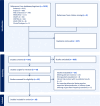Dosing practices, pharmacokinetics, and effectiveness of allopurinol in gout patients receiving dialysis: a scoping review
- PMID: 40131716
- PMCID: PMC12166007
- DOI: 10.1007/s40620-025-02269-7
Dosing practices, pharmacokinetics, and effectiveness of allopurinol in gout patients receiving dialysis: a scoping review
Abstract
Urate and oxypurinol, allopurinol's active metabolite, are predominantly eliminated by the kidneys. Therefore, optimising allopurinol dosing in patients on dialysis is challenging. This review explores allopurinol dosing practices, oxypurinol pharmacokinetics, and effectiveness in gout patients receiving haemodialysis or peritoneal dialysis (PD). Five databases and grey literature were searched. Studies on gout patients on allopurinol, receiving dialysis, and reporting dosing, pharmacokinetics, or effectiveness (reduction in urate and/or gout flares) were included. Abstract, full text screening and data extraction were done by two authors. Studies were grouped by dialysis modality. Eighteen studies were identified including 390 patients, most (n = 274, 70%) on haemodialysis with allopurinol administered after dialysis. The peritoneal dialytic clearance of oxypurinol (3.14 mL/min, n = 5) and urate (2.7-4 mL/min, n = 25) was similar. The haemodialytic clearance was 78-137 mL/min for oxypurinol (n = 21) and 80-165 mL/min for urate (n = 19). Allopurinol doses were higher in haemodialysis (100-600 mg/day) than PD (110-125 mg/day). Haemodialysis sessions decreased oxypurinol and urate concentrations by 39-57% (n = 30) and 56-71% (n = 6), respectively. Over time (1-230 days), urate concentrations in haemodialysis (n = 85) reduced by 14-41%. Target serum urate (< 0.36 mmol/L) was achieved in 61% (20/33) and 47% (13/28) of haemodialysis and PD patients, respectively. Gout flares decreased from 2 to 0.1 attacks/year in patients receiving dialysis (n = 79). Oxypurinol and urate clearance by haemodialysis was higher than PD, necessitating higher doses of allopurinol. POST dialysis allopurinol doses titrated to target urate are suggested. Future studies considering the impact of dialysis modality on allopurinol dose requirements are needed.
Keywords: Allopurinol; Dialysis; Gout; Pharmacokinetics; Urate.
© 2025. The Author(s).
Conflict of interest statement
Declarations. Conflict of interest: There are no declarations of conflict of interest relevant to the article’s content from our researchers. Funding: This work received no funding. Ethical disclosure: Ethical approval is not required for scoping reviews (no patient recruitment or primary data collection). Human and animal rights: This scoping review is based on publicly available data and did not involve human participants or animals. Informed consent: Informed consent was not required. (no patient recruitment or primary data collection). Author contributions: SS conceived the idea for this review, then developed the inclusion criteria with NK. NK was responsible for development of the search strategy, that was then validated by SS and DW. Title and abstract screening, full text review, and data extraction were done by NK, MS with referral to SS for disagreements. NK drafted the manuscript. All authors contributed to the development of the manuscript. Data availability: Data sharing is not applicable to this article as no datasets were generated or analysed during the current review.
Figures


References
-
- Singh JA, Gaffo A (2020) Gout epidemiology and comorbidities. Semin Arthritis Rheum 50:S11–S16. 10.1016/j.semarthrit.2020.04.008 - PubMed
-
- Kyu HH, Abate D, Abate KH, Abay SM, Abbafati C, Abbasi N, Abbastabar H et al (2018) Global, regional, and national disability-adjusted life-years (DALYs) for 359 diseases and injuries and healthy life expectancy (HALE) for 195 countries and territories, 1990–2017: a systematic analysis for the Global Burden of Disease Study 2017. Lancet 392:1859–1922. 10.1016/S0140-6736(18)32335-3 - PMC - PubMed
-
- Schlesinger N (2007) Diagnosis of gout. Minerva Med 98:759–767 - PubMed
-
- Schlesinger N, Thiele RG (2010) The pathogenesis of bone erosions in gouty arthritis. Ann Rheum Dis 69:1907–1912. 10.1136/ard.2010.128454 - PubMed
-
- TherapeuticGuidelines (2021) Gout. https://tgldcdp.tg.org.au/viewTopic?etgAccess=true&guidelinePage=Rheumat.... Accessed 28 June 2021
Publication types
MeSH terms
Substances
LinkOut - more resources
Full Text Sources
Medical

